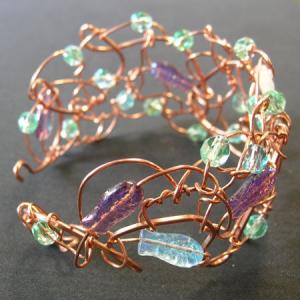Please Don’t Call Me a “Wirewrapper”
A few weeks ago I was listening to Jay Whaley’s Blogtalkradio interview with Helen Goga, former editor and publisher of The Wire Artist Jeweller magazine. One of the things that really struck me during the broadcast was the terminology each of them was using. Without fail, Helen made reference to “wire jewelry” and “wire jewellers”, while Jay said “wirewrapping” and “wirewrappers”.
For the past fifteen years, I have been exploring various techniques for manipulating wire to create jewelry, both simple and complex. From thick to thin, I’ve bent, linked, twisted, woven, hammered, fused, crocheted and knitted my way through many kilograms of metal. The possibilities of what can be made using wire are virtually endless. Much of my oeuvre has been created without the use of a torch. This is a deliberate choice: I enjoy the challenge of figuring out a design based on the constraint of working cold.
I am not a “wirewrapper”. I *never* refer to myself using that term. The reason is very simple: For many, the term “wirewrapping” conjures up images of someone who is unskilled and not serious about their craft. I’m neither, so when I talk to people about what I do, I tell them I am a professional artist/studio jeweller/metalsmith/instructor who makes jewelry out of wire. People understand these terms and respond with an open mind.
Helen alluded to the same thing during the conversation with Jay.
Potential clients and metalsmiths alike turn off when they hear the word “wirewrapping”. It’s like a kill switch. Seriously, mention “wirewrapper” or “wrapping” and the conversation stops. Dead. It doesn’t matter that my work has been published in books and magazines, or that it’s been included in national and international exhibitions. It. Just. Stops. Dead.
Oppi Untracht, in his book “Jewelry Concepts and Technology”, made reference to three major forms of metal used in jewelry: sheet, cast, and wire.[1. 1. At the time, metal clay had not yet been invented, otherwise it would likely have been included as well.] This book is considered by many in the craft to be the Bible of jewelry making. He devoted 111 pages to “The Uses of Drawn or Extruded Flexible Filaments”.[2. 2. Untracht, Oppi. Jewelry Concepts and Technology, (New York: Doubleday & Company, Inc., 1985) ISBN: 0-385-04185-3, Contents ix.]
Of course, there are metalsmiths who produce work in sheet metal, metal clay, and cast metal that is unsophisticated, but for some reason, the harshest critique seems to be reserved for wirework, and especially for cold-worked wire.
Why?
For many years, and for most of this past year in particular, I’ve been pondering this question. The answer is rather convoluted, and touches on many different areas, so I’m going to break it down into a series of essays that lay out what I see are the virtues and the vices of wire.
I’m going to look at wire jewelry through the eyes of the various communities with whom I interact: the general public, who buy jewelery; the wireworking community, made up of professionals and hobbyists, who share my passion for this form of metalwork; the students, who want and need the best quality instruction in order to succeed in their own practice; and, the greater metalworking community against whose standards of excellence wirework is compared and judged.
Please feel free to join in by posting comments below and by sharing anything that resonates with you.
Next> Why “Wire wrapping” is a Traditional Metalsmithing Technique




Great post! I don’t usually respond to posts, I read this quite randomly via facebook, but you stated this obvious conundrum so gracefully and I was online for the interview. I am a studio metalsmith (over 20 years) and also teach metalsmithing. I shudder when I hear students describe what they do in their own studio as “just wirewrapping”. I have great respect for the art of cold worked wire jewelry. (Also the same for good metal clay, polymer clay and glass bead artists.) I know if there were ever a “throw down” between me and a wire artist for a cold wire bezel set cab I would loose hands down!…and mangle the hell out of the wire!
Keep twisting!
Thank you so much for your comment Julie! I shake my head whenever I hear someone refer to it as “just wirewrapping” too. Over the years, I’ve gotten to know many, many very talented wire artists, and there is no “just” about what they do. Congratulations on your Grand Prize win with the Lark Books Design Challenge!
Awesome post! I really appreciate the useful information that you shared here. It is really beneficial read for me. Thanks for sharing
Excellent post, Dianne! You know I’ve been looking forward to this ‘series’ for a while. :^D I know this conversation is a daily part of your personal and professional life, as it is for so many of us. Thanks for the willingness to share.
It is so gratifying to see that a metalsmith of Julie Sanford’s caliber respects the genre. So many metalsmiths engage in a form of snobbery about wire and your example of how stubborn and closed-minded they can be is unfortunately very common.
It is also common for many wire artisans to knuckle under to that snobbery, even when their work is compared unfavorably to something as simple as a hammered and stamped copper washer on an earring finding. It is apparent that collectively, we need to change our own attitudes just as much as we need to create a new vocabulary.
You have opened the conversation in a very straightforward way – and you know we love it!
I’m hoping that it will be a conversation that opens many minds and hearts.
I never thought about the terms used before but I’ll be thinking about it now. Thanks!
Thanks Perri & Joella! Changing the terminology is the first step, and it opens the door. I have found that once I’ve been able to initiate the conversation, the response has generally be favourable from all quarters.
I keep coming back to your blog post, and I eagerly await the rest of the installments.
I have suffered some unjust evaluations and assumptions of my work by those who are professionals in the field due to the fact that I work with wire.
It is very hard for me to stand up to those people because they are professionally trained with degrees in an accepted field.
The sometimes complete dismissal of my work because it is in wire is very discouraging since I do put my heart and soul into problem solving and attempting new ideas and strive to be as innovative as my self teaching allows at the present moment.
There isn’t really any school to attend that teaches wire specifically and most wire artists are forced to be self taught if they want to progress.
The same people who have dismissed me have shown approval to some horrible ‘art jewelry’ that appears as though made by a kindergardner. Even with such poor judgement on display, I find it difficult to dismiss their comments and derision.
One of the toughest things I had to learn was that professionally training does not necessarily equal better. It does sometimes make it easier, because you don’t end up re-inventing the wheel, and there are connections that you make through the school system that can help you in your career. That said, it’s easy to get stuck in the training too. If you are doing your best to improve your skills, to innovate and to produce the best work you can you’re already doing everything that you need to.
Even though there isn’t a school specifically for teaching wirework, there are opportunities for constructive feedback: the International Guild of Wire Jewelry Artists has a forum specifically devoted to offering critique for those who ask for it.
As for showing approval for horrible art jewelry, well, remember that art is subjective.
I’m still doing some research in connection with my next post, but it’s coming soon! Thank you very much for posting your comment!
Diane,
I am late in reading this thread. There are far too many arrogant metal workers who want to look down their noses and label those working with wire disdainfully as “wire wrappers,” and you have clearly identified one.
Sad that this attitude circulates as it does, amongst some who are in a position of trust. I spent a lot of time ameliorating and soft pedaling the potential damage. No longer my job.
Some of the finest wire workers I know create Fine Jewelry, and command respect of many, deservedly.
There are “wire wrappers” who care about the quality of their work, and seek out workshops, and upgrade their skills. There are also those who believe their work sells, and that is enough. No need to take a workshop, no need to improve. Yes, there are buyers, too many undervalue their time to keep their prices low, to sell.
Every coin has two sides.
More at another time.
Hugs,
Terrie
I agree with you and I am glad you are exploring this. I refer to myself as a jewelry designer working in wire. I think I do very nice work, and I have pieces in several galleries. But I find that that metalsmiths, and people who own a lot of fabricated pieces tend to snub pieces done in wire, on the sole basis that they are done in wire. It’s very interesting. It’s like if you can tell it’s been made out of wire, it suddenly becomes inferior. Our work must be styled like minimalist, fabricated work, or be overtly modern or conceptual to be valid.
I recently removed the only two pieces I had posted on a forum, because of this prevalent opinion… I wasn’t asked to do that, but I also know my style, which is not modern, will not be appreciated there.. I think wire is one of the most wonderfully free, organic ways to use metal, and I think it is better to explore style within a much broader spectrum than trying to mimic work done by other methods.
To be called an artist is usually a big compliment, but I consider being called a craftsman a compliment also. To be a good craftsman takes skill and not everyone can be a wire artist. It is a hard thing to make a stone fit into a wire without solder. There will always be snobs at everything that is done. I have met snobs when it comes to painting, such as a tole & decorative painter verses a canvas painter. To enjoy what you do, and do it well is pride in ones work. You will not always be excepted but we need to be patient and explain our work. Kill them with kindness works for me, most of the time. I enjoyed the article and pictures of the work. I once was in the wire artist, what fun that was. Iona
Hi Iona – Yes I remember your feature in WAJ! Thank you for adding your thoughts!